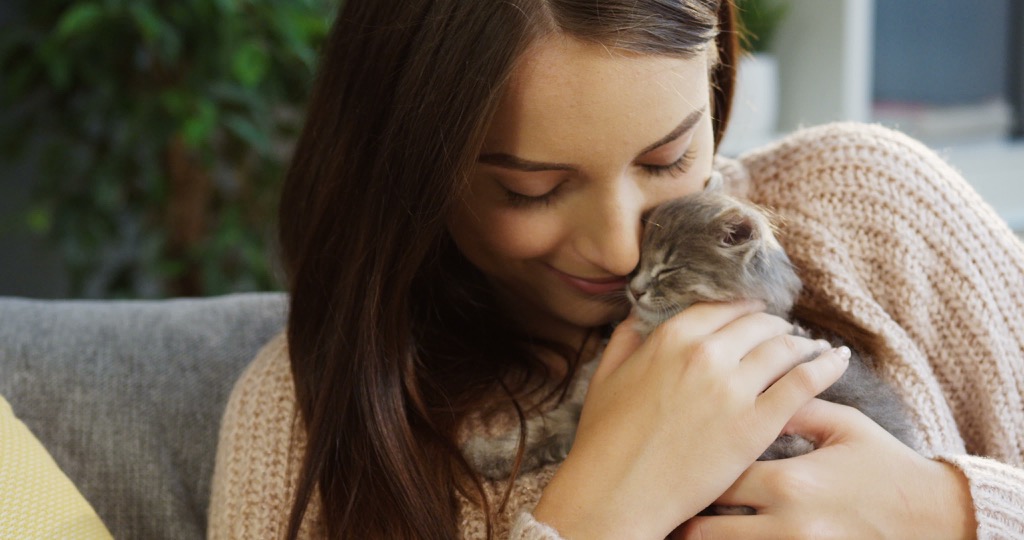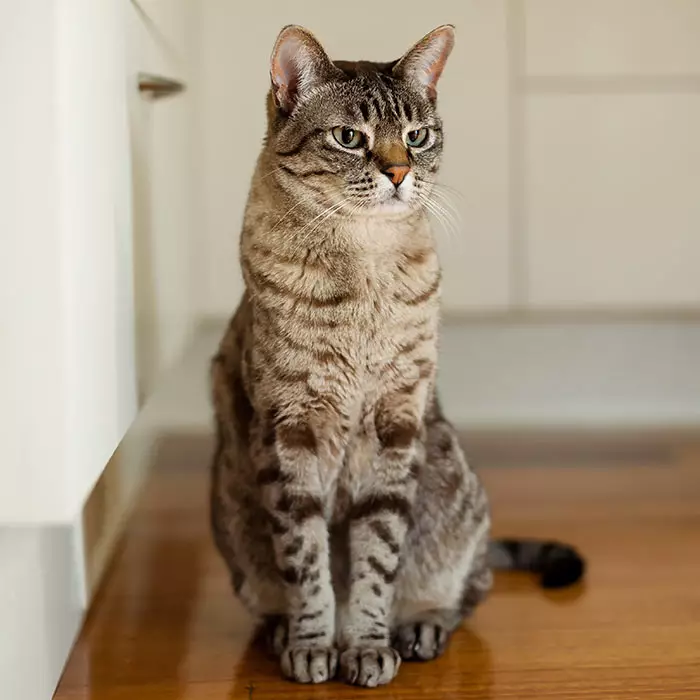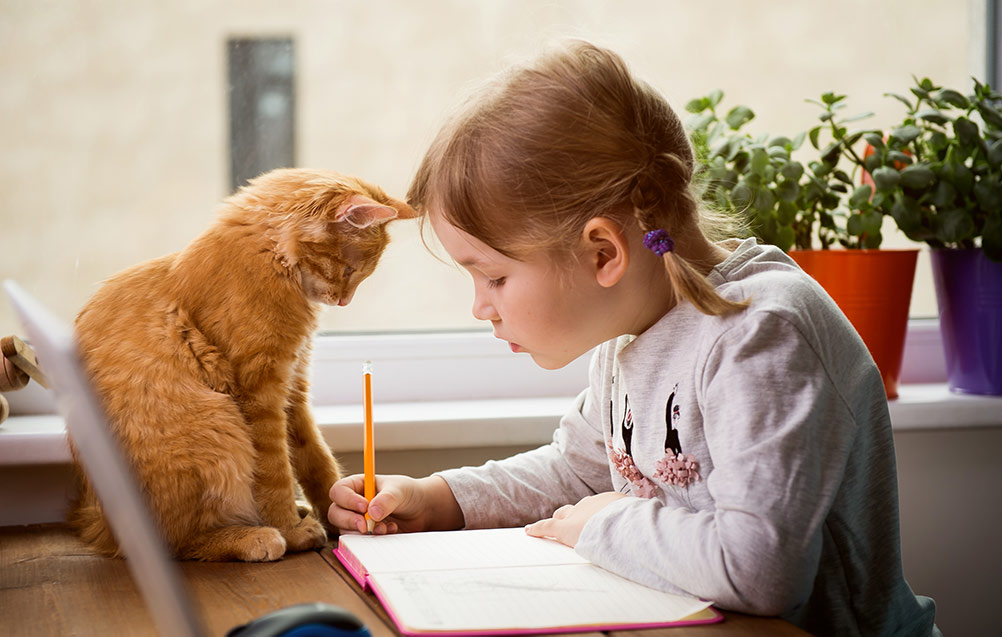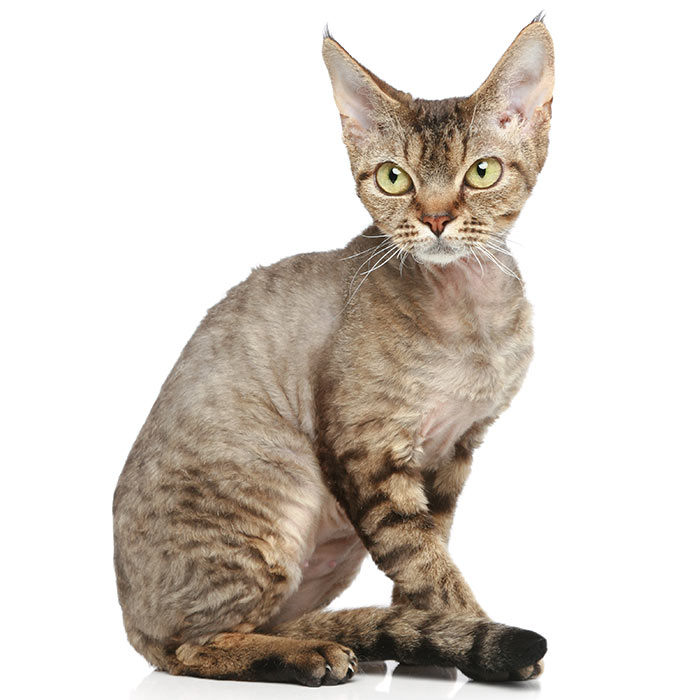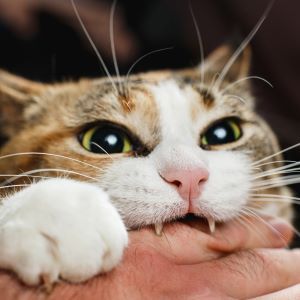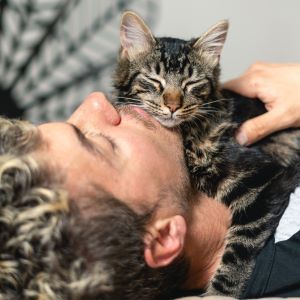Cat tail signs: What your cat’s tail tells you
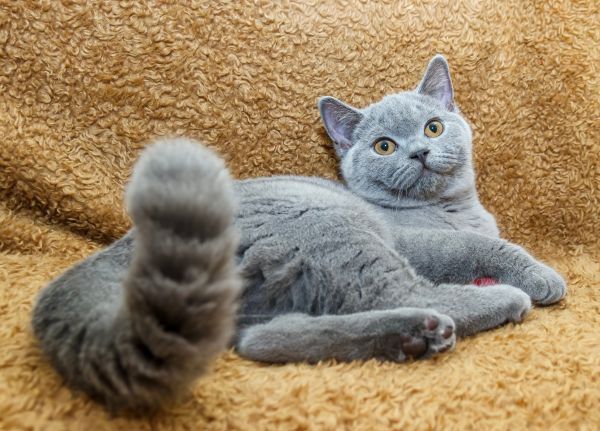
Do you have any idea what your cat’s tail is telling you? When it points up in the air, or straight out behind? How about when it twitches vigorously or sways gently? Like dogs, cats use their tails as one element of their complex communication system. However, cats’ tails speak a very different language to dogs’ tails, often leading to understandable confusion among the humans (and dogs) who share their homes!
Feline communication comprises body language, vocalisation, and even scent cues that we humans can’t detect. It can be as obvious as a loud hiss or as subtle as a gentle flick of the tail. Body language can be expressed via a cat’s facial expressions, fur and body posture, and well as its tail. All these elements work together to send a message, so be aware that observing the tail alone won’t provide the full picture.
Did you know?
A cat with a tail pointing straight up in the air, erect ears and flat fur is usually happy, but a cat with straight-up tail but whose fur is puffed out and whose ears are flattened, is more likely to be angry or scared.
Your cat’s tail could indicate illness
It’s important to be aware that a cat’s tail position can sometimes indicate sickness, though it’s just one of many clues to watch for. Cats use their tails to communicate mood and physical well-being, and changes in tail carriage, such as tucking the tail between the legs, or a limp, dragging or rigid tail, may signal that something is wrong.
Tail changes combined with other symptoms—like loss of appetite, hiding, aggression, or reduced grooming—should be taken seriously. These are often signs your cat is feeling unwell. If you’re unsure, it’s always best to consult your veterinarian, especially if tail behaviour is out of character or persists for more than a day.
Unsure how serious it is?
Bow Wow Meow policyholders can get access to trusted vet care anytime, anywhere, at no additional cost. Connect to an experienced Australian registered vet via video call, 24/7. Whether it’s providing vet advice, setting up at-home treatment plans, or confirming if you need to visit a vet in person, you can get help when you need it.
Find out more about our pet insurance cover options.
What your cat might be trying to tell you with her tail position
Although you should look at more than just her tail to fully understand your cat’s emotional state, the tail is perhaps the most expressive part of a cat’s body language. It ‘speaks’ not just through its position – whether straight up or down, curled up or down, or somewhere in between – but also by its movement – whether flicking furiously, swaying gently, or merely twitching at its tip.
Did you know?
Generally, a friendly cat uses her tail to decrease the distance between herself and others, while an angry or frightened cat uses her tail try to increase the distance.
Here are some common cat tail positions and what they typically mean:
Tail pointing straight up

A tail pointing straight up is usually a sign of a contented, confident and sociable cat. She is feeling happy and is approaching in a friendly manner (this is how kittens tend to greet their mothers).
When she holds her tail this way, she’s ready to interact, so it’s a great time to engage in play and cuddles with her. Watch the tip of an erect tail – a little twitch can mean a particularly happy moment.
Did you know?
You may notice that sometimes your cat’s tail looks like a question mark—it stands upright and curls at the end. This cat tail position also indicates that your cat is happy and approaching amicably.
Puffed tail pointing up and curling forward

A cat’s tail that is held upright, but concave, with the hairs puffed out like a pipe cleaner to make her look bigger and scarier, indicates a severely agitated and frightened cat. She is being defensively aggressive in order to ward off danger. Other signs of aggression might include standing with an arched back, hairs on the spine standing up, ears flattened backward on the head, and tail held erect.
If your cat assumes this position, leave her alone; she may perceive your approach as a threat and become aggressive. Rather, try to identify the threat and, if possible, remove it. It may be another animal in or outside the home, visitors approaching or even a sudden noise.
Tail up with a U-shaped curve

A tail that curves in a gentle U is usually a sign of a relaxed cat. The more interest she feels, the higher the tail. A curved tail that flips forward over her back is a calm, welcoming position – she is happy to see you and is approaching amicably.
Sometimes, this posture can also signal indecision – the cat hasn’t decided what their next move will be.
Did you know?
This is a common way in which cats greet familiar humans. In response, you can offer your hand for sniffing and petting.
Tail up at a 45-degree angle
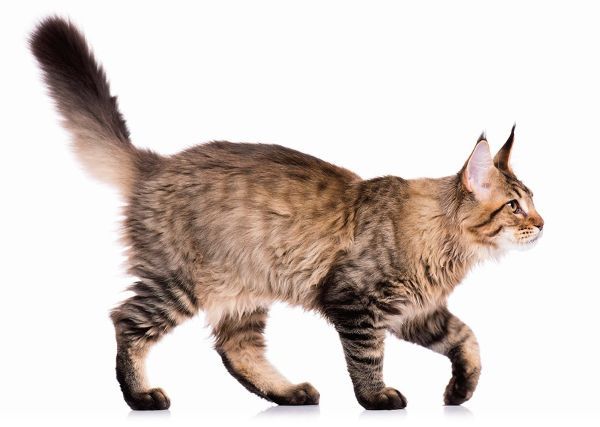
A tail held out behind but angled up may mean your cat is unsure how to feel right now. And a tail held behind, angled up and away from the body but twitching back and forth is most likely an expression of indifference toward whatever they are encountering.
Tail held horizontally behind the cat

This neutral position could convey a few feelings. Your cat may be alert, confident, relaxed or amicable. If the tail is held straight out in a rigid position, almost level with the spine, it can also indicate that your cat is feeling uneasy, but not afraid. Interpretation depends on the situation and the rest of your cat’s body language.
Tail hanging down
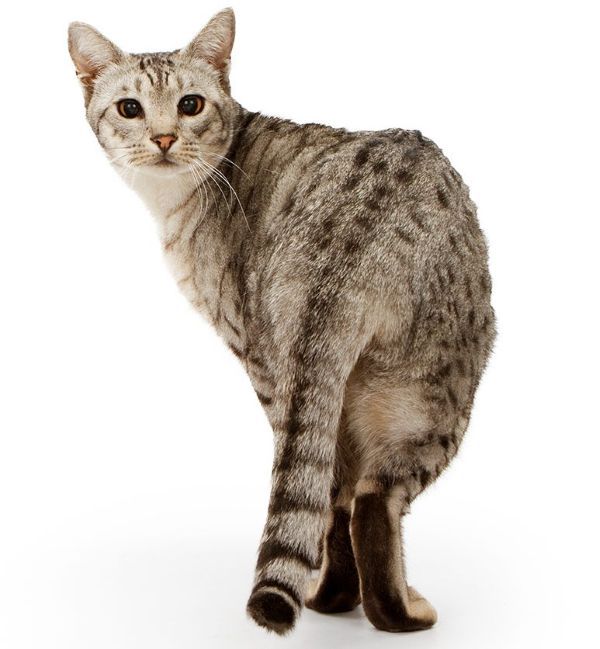
A calm cat stands with a straight back, head held high with erect ears, no erect hairs, and her tail hanging in a relaxed manner. However, cats may also lower their tails below the level of their backs if they are frightened or anxious. A lower tail is often a sign of a very serious mood; many of the cat’s tail down positions signal aggression, defensiveness or submission.
Did you know?
Certain breeds, for example Persians, tend to carry their tails low for no particular reason.
Puffed tail hanging down
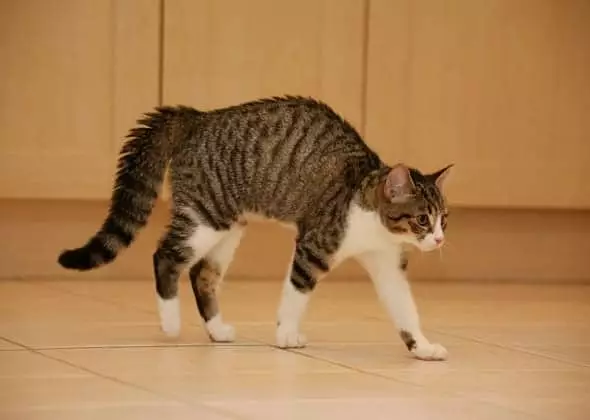
A “bottle brush” hanging tail can indicate that the cat feels threatened and is being defensively aggressive. The hair on their spine also stands up, making them seem larger. If you try to interact with your cat, she may perceive your approach as a threat and become aggressive.
Tail hanging down with a curve
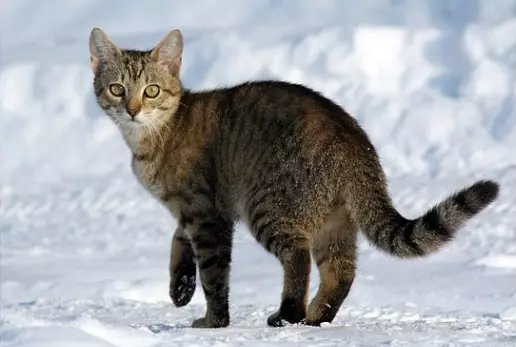
If the tail is hanging down with a dip near the base, it can be a sign of aggression. A bottlebrush tail held downwards in an inverted U shows fear or defensiveness, and if provoked, the cat may fight back with all claws bared.
Tail straight down or held low to the ground
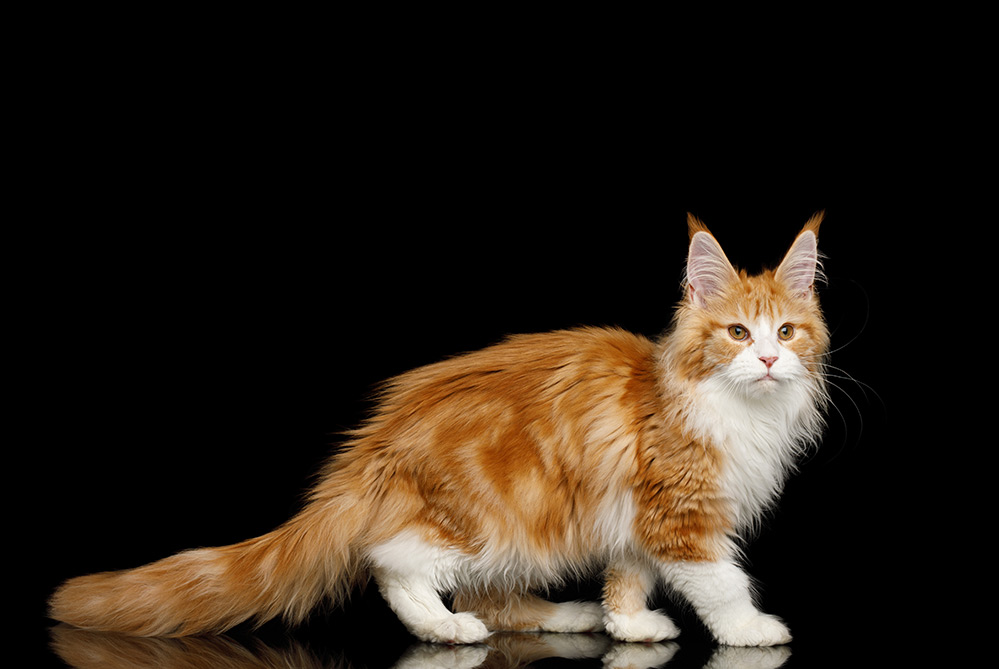
A tail carried all the way down may mean that a cat is feeling defensive and that aggressive behaviour might follow. Don’t try to engage or pet her; rather, try to neutralise whatever is upsetting her.
Tail tucked under or next to their body

A tail curved beneath the body signals fear, nervousness or submission. Fearful cats will often lie prone with ears held outward and flattened, and tail tucked under body. When you see this, end your interaction with your cat and ensure that your cat’s environment is free of stressors.
Did you know?
If your cat frequently crouches with their tail curled tightly around their body for more than a few days, it can be a sign that she is in pain or feeling unwell. Often, her head will also be tucked in. It’s a good idea to see your veterinarian to rule out pain or illness.
Tail held between the legs
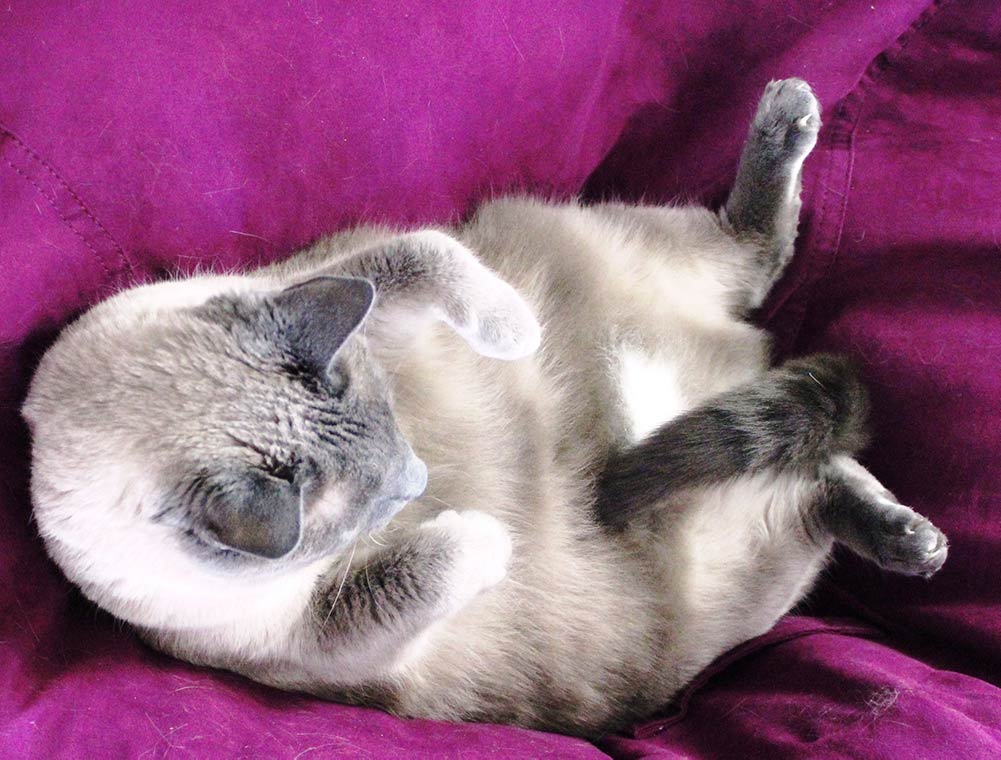
This is a submissive position that’s likely trying to convey that your cat is scared, upset or wants to be left alone. Unlike the bristled tail, a submissive tail can make a cat look smaller and less threatening to another aggressive cat. If you see her in this position, don’t approach. If cornered, she may still hiss, scratch and/or bite, or turn on her back with her claws up, ready for defence.
What your cat might be trying to tell you with her tail movements
 Tails can move quickly or slowly, or they can be completely still. A moving tail in cats generally indicates arousal of some sort, such as excitement, fear or aggression. Tail movement adds another layer of complexity to cat tail language, making it even more confusing to understand.
Tails can move quickly or slowly, or they can be completely still. A moving tail in cats generally indicates arousal of some sort, such as excitement, fear or aggression. Tail movement adds another layer of complexity to cat tail language, making it even more confusing to understand.
And it’s not only us humans who are left shaking our heads in bewilderment. Be aware that dogs may mistake the tail-wagging cat as an invitation to approach, because dog tail wagging usually means “come close, let’s be friends”, but not so for cats!
Tail whipping/ swishing/ thrashing back and forth
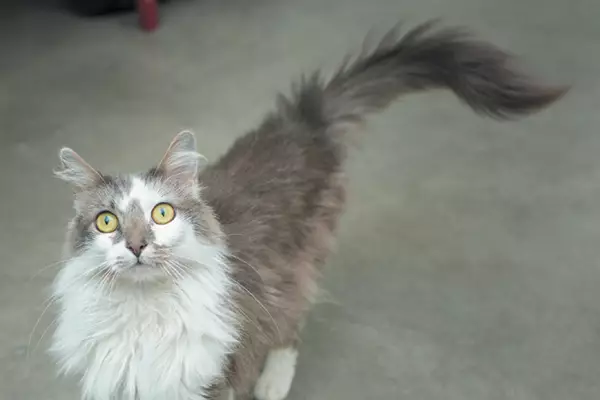
A rigid tail that is held lower and slaps back and forth rapidly usually indicates fear, annoyance, anger and/or aggression. She is using her tail to increase the distance between herself and whatever is bothering her. Often it is accompanied by her leaning away and turning her ears back. This is definitely not the time for physical contact.
Tail angled down and wagging
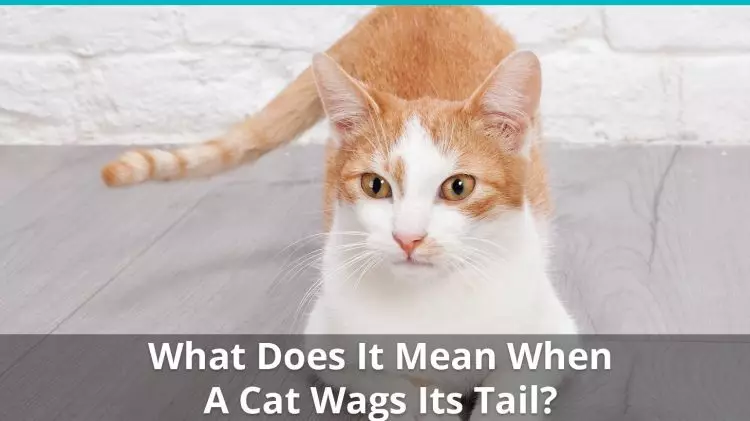
This can indicate either ‘good’ excitement or ‘fearful’ excitement. When your cat is frightened, her tail may wag in a low position. In contrast, a cat that is relaxed and simply surveying the environment may also have the tail lowered but will move it leisurely and her other body language is generally also much more content.
Tail wagging or flicking while lying down
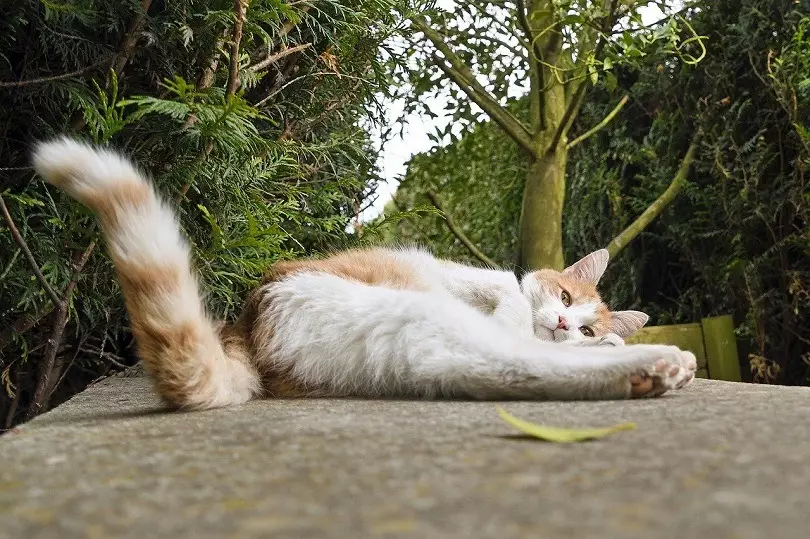
If your cat is continually wagging her tail back and forth while lying down or flicking it with little bursts of energy, it’s likely that she is expressing her annoyance. Either she doesn’t want to be bothered at the moment, or her territory is being invaded by other animals or interfering humans.
Tail swaying slowly from side to side
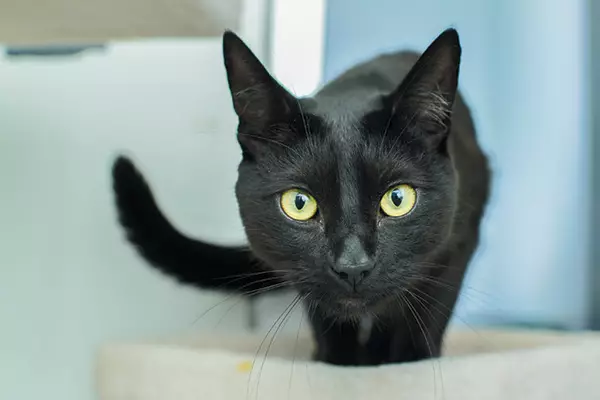
In cat tail language, a slow swaying tail often means that the cat is focused on something or engaged in predatory behaviour. It might precede her stalking or pouncing on a toy or item of food. Unless this will cause harm, try not to interfere or distract her; rather, let the captivated cat follow her interests.
Tail high and swishing/wagging
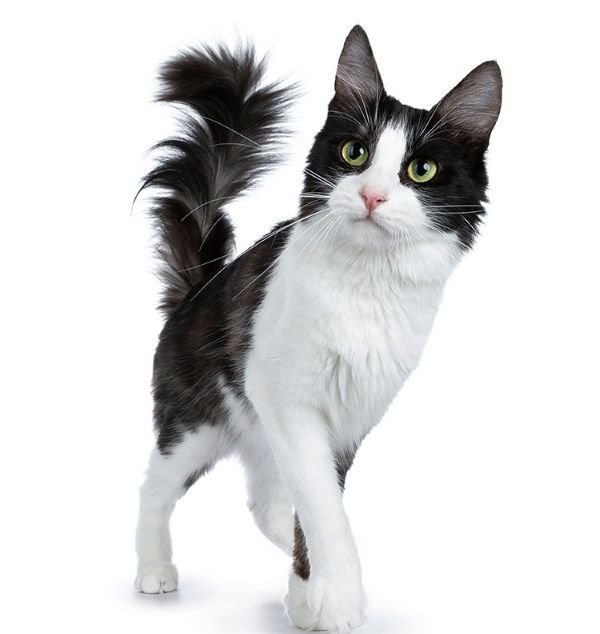
The cat is probably feeling happy and pretty confident while strutting around. This combination of high tail position and slight movement sends a message to other cats and her owner that she’s amenable to some petting and playtime.
Tail upright and quivering

Your cat may quiver or wag her upright tail in a shaky motion when she is especially excited to see you or another cat. This is a good sign when you enter the room because it means your cat is happy to see you. If your cat’s tail quivers and she dances on her back feet, she’s giving you an ecstatically happy greeting.
Did you know?
Un-neutered cats use this same posture – quivering their upright tail – while backing up against a vertical surface, when they want to mark a place by spraying it with urine.
Twitching the tip of the tail

Cats twitch the end of their tails when they are hunting and playing, as well as when they are mildly irritated and frustrated. As there are varying reasons why she might be twitching her tail tip, observe the scene and look for other body language clues.
Sitting upright with tail tip moving can indicate that the cat is alert and interested. However, tail twitching can also be associated with heightened emotion or aggression. The more the tail is flicking back and forth, the less happy the cat is. Rapid tail movement means they’re sending a warning to another cat or human to back off.
Did you know?
Twitching the tail tip while holding it low and straight is often associated with hunting behaviour. During hunting, the body is in a crouched position ready to pounce. The crouch and moving tail tip indicate an intense focus on prey.
Hitting with the tail
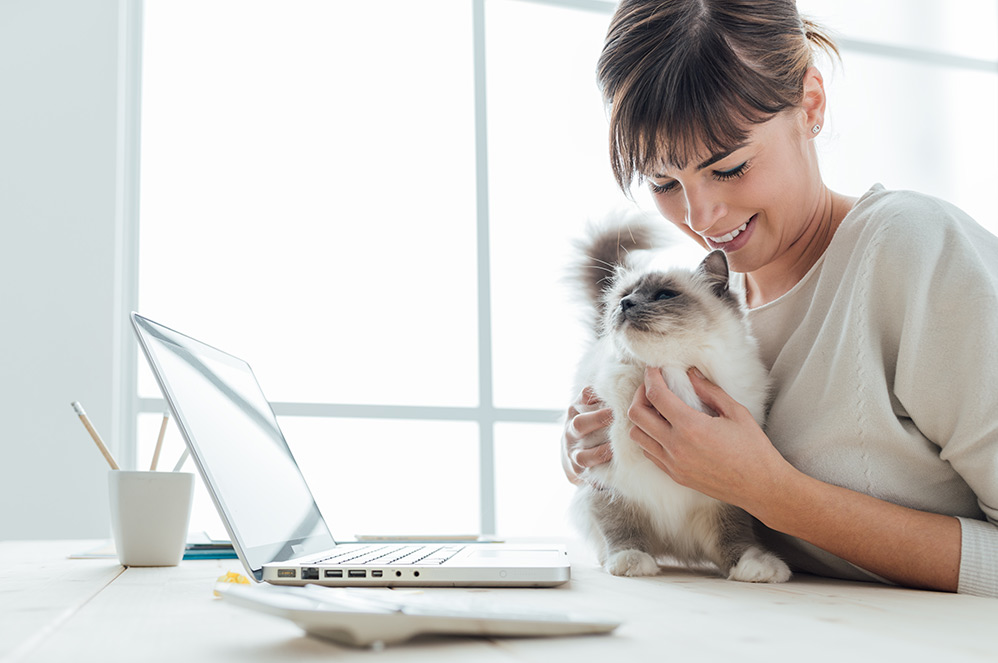
Cats hit you with their tail to get your attention. A cat seated at your feet and gently hitting you with her tail is likely showing you a sign of affection not all that different to petting you. However, being hit by a tail can also signal a cat that is irritated, lonely, affectionate, anxious, or hungry.
Tail wrapped around a person or another cat
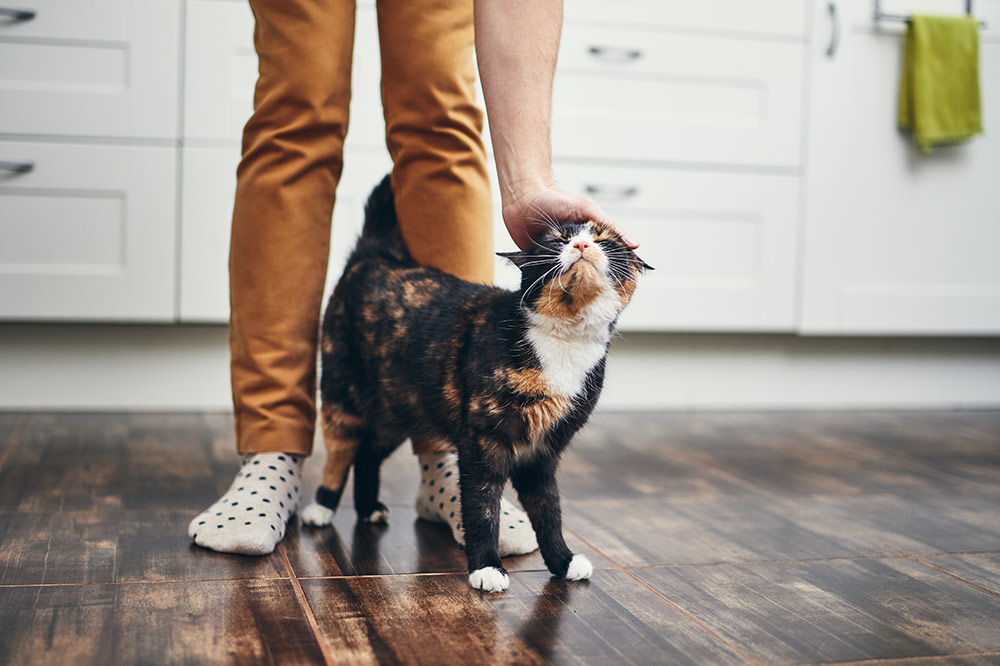
Cats who are feeling friendly and wish to interact may greet people by curling their tails around them and by intertwining their tails with other cats. Sometimes cats will twine their tail around a person’s legs in a bid for attention or food. It’s also a marking technique to say, “This person is mine.”
In summary
 Cat tail language has been the focus of study by animal behaviourists in order to help guide owners to better understand their cats. Unfortunately, learning to interpret cat tail language is a little like learning a foreign language: It takes time and it can be extremely confusing. Just as we think we’ve got the gist of what our cat is telling us, they confuse us with a new tail signal or use a familiar one in a completely new way!
Cat tail language has been the focus of study by animal behaviourists in order to help guide owners to better understand their cats. Unfortunately, learning to interpret cat tail language is a little like learning a foreign language: It takes time and it can be extremely confusing. Just as we think we’ve got the gist of what our cat is telling us, they confuse us with a new tail signal or use a familiar one in a completely new way!
Nevertheless, it’s important that cat owners make an effort to recognise feline “tail talk” because many feline behaviour problems stem from miscommunication. Cats try to tell us how they feel and what they want, and it must be very frustrating for them when we don’t understand. Learning to interpret your cat’s tail signs as part of her overall body language will definitely pay off in the long run – it will give you greater insight to her moods and feelings and is sure to enhance your relationship.
FAQ’s
How do cats use their tail to show affection?
Cats often express affection and contentment through their tails. A gentle curling of the tail around their human’s legs or another cat is a common sign of affection. Additionally, a lightly quivering tail combined with purring or rubbing indicates excitement and happiness to see someone they are fond of. Understanding this cat tail meaning can help owners better respond to their cat’s emotional needs.
What does a twitching tail mean in cat tail language?
A twitching tail, where the tip or the whole tail makes slight twitch movements, often indicates a state of focused attention or slight irritation in cats. If a cat is hunting or watching something intently, a twitching tail reflects concentration. However, if you’re petting your cat and its tail starts twitching, this could be a sign that it’s becoming annoyed or overstimulated and might need a break.
Can the movement of a cat’s tail indicate happiness?
Yes, the movement of a cat’s tail can definitely indicate happiness. A cat holding its tail upright with a slight curl at the end is typically a happy cat. Also, a slow, sweeping tail movement from side to side in a relaxed manner while lying down usually shows contentment. These signs help cat owners recognize when their pet is feeling pleased and relaxed.
What does it mean when a cat wraps its tail tightly around its body?
When a cat wraps its tail tightly around its body, it can be a sign of self-comfort and protection. This cat tail meaning often indicates that the cat is trying to keep warm or protect itself, possibly feeling unsure or uncomfortable about its surroundings. It can also be a position of rest, signalling that the cat is just trying to conserve body heat and not necessarily distressed.
What should you interpret from a cat flicking its tail side to side?
A cat flicking its tail side to side vigorously often signifies agitation or anger. This type of cat tail language shows that the cat is likely feeling threatened or frustrated with a situation. If you notice your cat flicking its tail while its ears are pinned back or its body is lowered, these are additional signs that it is best to give your cat some space as it may be prepared to defend itself.
These FAQs delve into the nuanced world of feline communication through tail movements, providing cat owners and enthusiasts with valuable insights into understanding and responding to their cats’ emotional states and needs more effectively.
Bow Wow Meow Pet Insurance can help protect you and your cat should an unexpected trip to the vet occur.
-
Find out more about our cat insurance options
-
Get an online pet insurance quote
Bow Wow Meow is proud to have been awarded winner of Canstar’s ‘Most Satisfied Customers’ Award in the Pet Insurance category for both 2024 and 2025!
Bow Wow Meow is proud to have been chosen as Product Review’s Pet Insurance Award Winner every year from 2018 to 2025! This is based on 2,995 independent customer reviews (as at 21/01/2025), with an overall rating of 4.3*
Google Review rating = 4.5* (based on 968 reviews)
Trust Pilot rating = 4.6* (based on 531 reviews)
Bow Wow Meow is proud to have been chosen as Product Review’s Pet Insurance Award Winner every year from 2018 to 2025! This is based on 2,995 independent customer reviews (as at 21/01/2025), with an overall rating of 4.3*
Google Review rating = 4.5* (based on 968 reviews)
Trust Pilot rating = 4.6* (based on 531 reviews)
Bow Wow Meow has been chosen as a winner in the Finder Pet Insurance Awards 2024. Finder’s panel of experts analysed over 140 quotes to award our Ultimate Care Plan the winner of the “Pet Insurance – Value” category.



